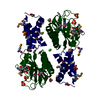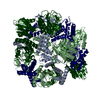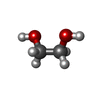+検索条件
-Structure paper
| タイトル | The Structural Basis of T4 Phage Lysis Control: DNA as the Signal for Lysis Inhibition. |
|---|---|
| ジャーナル・号・ページ | J Mol Biol, Vol. 432, Issue 16, Page 4623-4636, Year 2020 |
| 掲載日 | 2020年7月24日 |
 著者 著者 | Inna V Krieger / Vladimir Kuznetsov / Jeng-Yih Chang / Junjie Zhang / Samir H Moussa / Ryland F Young / James C Sacchettini /  |
| PubMed 要旨 | Optimal phage propagation depends on the regulation of the lysis of the infected host cell. In T4 phage infection, lysis occurs when the holin protein (T) forms lesions in the host membrane. However, ...Optimal phage propagation depends on the regulation of the lysis of the infected host cell. In T4 phage infection, lysis occurs when the holin protein (T) forms lesions in the host membrane. However, the lethal function of T can be blocked by an antiholin (RI) during lysis inhibition (LIN). LIN sets if the infected cell undergoes superinfection, then the lysis is delayed until host/phage ratio becomes more favorable for the release of progeny. It has been thought that a signal derived from the superinfection is required to activate RI. Here we report structures that suggest a radically different model in which RI binds to T irrespective of superinfection, causing it to accumulate in a membrane as heterotetrameric 2RI-2T complex. Moreover, we show the complex binds non-specifically to DNA, suggesting that the gDNA from the superinfecting phage serves as the LIN signal and that stabilization of the complex by DNA binding is what defines LIN. Finally, we show that soluble domain of free RI crystallizes in a domain-swapped homotetramer, which likely works as a sink for RI molecules released from the RI-T complex to ensure efficient lysis. These results constitute the first structural basis and a new model not only for the historic LIN phenomenon but also for the temporal regulation of phage lysis in general. |
 リンク リンク |  J Mol Biol / J Mol Biol /  PubMed:32562709 / PubMed:32562709 /  PubMed Central PubMed Central |
| 手法 | EM (単粒子) / X線回折 |
| 解像度 | 1.65 - 9.4 Å |
| 構造データ |  EMDB-22250:  PDB-6psh:  PDB-6psk:  PDB-6px4:  PDB-6pxe: |
| 化合物 |  ChemComp-EDO:  ChemComp-HOH:  ChemComp-SO4:  ChemComp-BTB:  ChemComp-CL: |
| 由来 |
|
 キーワード キーワード | VIRAL PROTEIN / phage / lysis inhibition |
 ムービー
ムービー コントローラー
コントローラー 構造ビューア
構造ビューア 万見文献について
万見文献について



 Escherichia phage T4 (ファージ)
Escherichia phage T4 (ファージ)